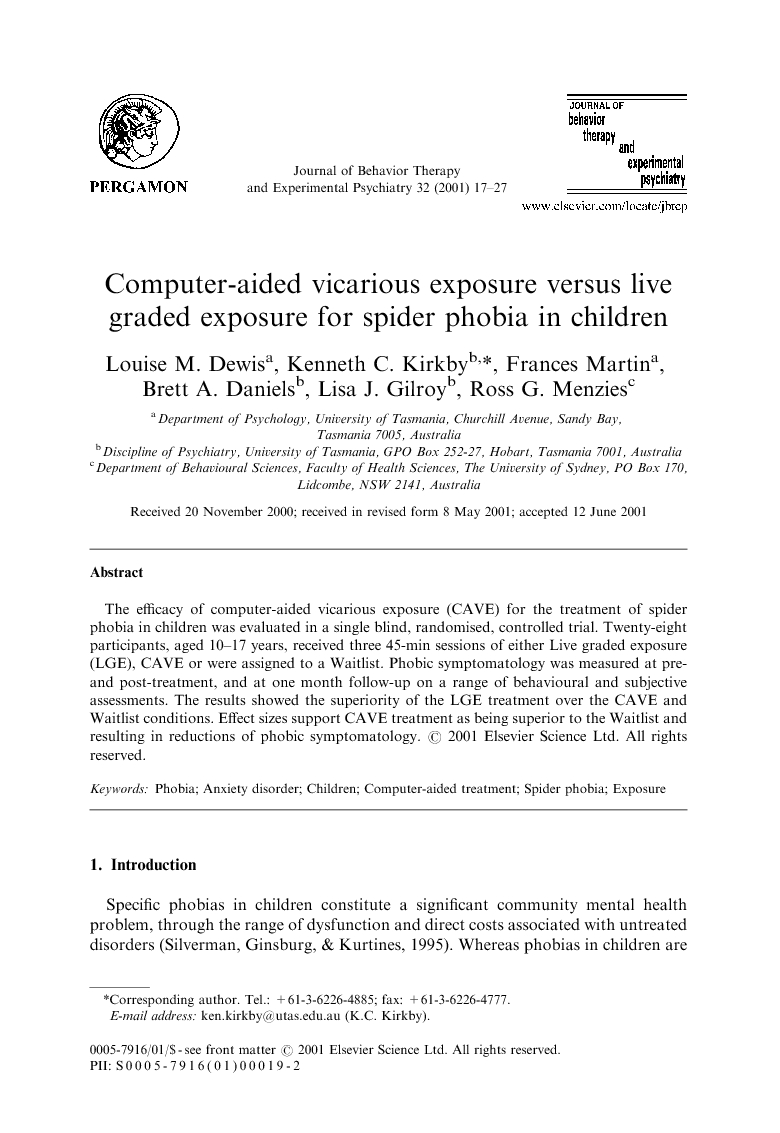The efficacy of computer-aided vicarious exposure (CAVE) for the treatment of spider phobia in children was evaluated in a single blind, randomised, controlled trial. Twenty-eight participants, aged 10–17 years, received three 45-min sessions of either Live graded exposure (LGE), CAVE or were assigned to a Waitlist. Phobic symptomatology was measured at pre- and post-treatment, and at one month follow-up on a range of behavioural and subjective assessments. The results showed the superiority of the LGE treatment over the CAVE and Waitlist conditions. Effect sizes support CAVE treatment as being superior to the Waitlist and resulting in reductions of phobic symptomatology.
Specific phobias in children constitute a significant community mental health problem, through the range of dysfunction and direct costs associated with untreated disorders (Silverman, Ginsburg, & Kurtines, 1995). Whereas phobias in children are usually transitory (American Psychiatric Association, 1994) (APA), the relatively high prevalence of the disorder in the adult population (Regier, Narrow, & Rae, 1990), and early onset of the phobia (Öst, 1987), indicates some continuity into adulthood. Further, phobias that persist into adulthood remit infrequently (APA, 1994). Hence, early intervention to facilitate normal development, would appear to be an effective avenue for reducing the high prevalence in the adult population.
Live graded exposure (LGE) is the treatment of choice for specific phobia (Foa & Kozak, 1985). Although the efficacy of this technique is well established, the cost, duration, accessibility, and labour intensive nature of treatment may exclude many individuals from seeking treatment (Greist, 1989). Additionally, parents may underestimate the severity of anxiety symptoms in their children (Craske, 1997). Innovative solutions that provide greater access to treatment are required.
Computer-based cognitive-behavioural treatments have several advantages over therapist-delivered treatments including increased therapeutic time, around the clock availability, easier and earlier access to care and consistent and replicable delivery of the treatment steps (Marks, 1998). Computerised instruction in constructing self-exposure hierarchies (Carr, Ghosh, & Marks, 1988) has produced significant and comparable improvements to therapist-instructed exposure in adults. Virtual reality techniques delivering exposure therapy have produced successful outcomes in small samples of adults with claustrophobia (Botella et al., 1998), acrophobia (Hodges et al., 1995), and spider phobia (Carlin, Hoffman, & Weghorst, 1997). An interactive variant of symbolic modeling with coping, computer-aided vicarious exposure (CAVE) (Kirkby, Daniels, & Watson, 1992) has produced clinically and statistically significant reductions in spider phobia symptom severity in adults comparable to therapist-delivered LGE (Gilroy, Kirkby, Daniels, Menzies, & Montgomery, 2000).
Given these indications of therapeutic benefit and the effective and widespread use of computers in educational settings (Fatouros, 1993; Trinidad, 1994), computer-based techniques would appear to be well placed to address the need for early intervention in childhood specific phobias. However, the efficacy of these approaches for treating children has not been systematically investigated. One case study reported the use of a one-hour computer-delivered exposure treatment, in two children, to be ineffective in reducing symptom severity (Nelissen, Muris, & Merckelbach, 1995).
Further research is needed to evaluate computer-based approaches for treating childhood specific phobia. The current study aims to address this issue by evaluating the efficacy of an interactive CAVE program in comparison with therapist-aided LGE and a Waitlist Control group for children with spider phobia. Based on the successful outcomes reported using interactive vicarious exposure techniques for adult spider phobia (Gilroy et al., 2000), it is hypothesised that CAVE treatment will be comparable to LGE in producing significant reductions on a range of phobic symptom and behavioural avoidance measures and that both CAVE and LGE will be superior to the Waitlist Control.


